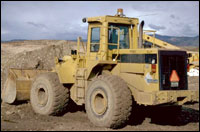Yes, dear skeptics, you heard correctly: The Bush administration done good this week.

Digging these new rules.
Landmark controls on diesel emissions, finalized Tuesday by the U.S. EPA, are expected to prevent 12,000 premature deaths and 15,000 heart attacks each year.
And these were no warmed-over regs from the Clinton era, passed off as the Bushies’ own, as was the case with the Highway Diesel Rule, a tough new standard that will dramatically reduce diesel pollution from trucks and buses starting in 2007. The Bush EPA can claim all the credit for this initiative, which regulates “non-road” diesel-powered equipment such as bulldozers, forklifts, tractors, and generators — sources responsible for a surprising 60 percent of all diesel particulate matter, which is suspected of causing cancer.
The regulations require manufacturers to build 90 percent cleaner diesel engines for these non-road machines, and call for a whopping 99 percent reduction of the sulfur content in the diesel fuel that will power the updated engines.
Enviros far and wide have sounded positively starry-eyed in their accolades: “The EPA staff have been phenomenal on this issue,” said Richard Kassel, a Natural Resources Defense Council senior attorney who helped the agency draft the regulations. “They went out of their way to give us as much of a voice in this regulatory process as they did industry. Nobody can deny that this will be remembered as a historic victory for clean air.”

Hoe hoe hoe.
Fair enough, but before we start thinking that the Grinch’s heart has grown three sizes, a reality check is in order. Peer behind the curtain of the two-year process leading up to Tuesday’s announcement and you’ll see that the stars were unusually well-aligned to usher this initiative past the usual Bush administration roadblocks — aligned in a way that they will not likely be on other issues anytime soon.
For one thing, industry was on board fairly early on. As Edward Murphy of the American Petroleum Institute told The New York Times, “This means a huge investment for us, in the billions. We’re concerned about the cost, but it’s worthwhile because the environmental benefits justify it.”
Well, sort of. It’s true that EPA numbers predict staggering health benefits from the regulations — some $80 billion in savings from prevented heart attacks, asthma cases, and premature deaths, compared to about $2 billion in costs to industry.
It’s also true that from an industry standpoint, that $2 billion investment is worthwhile because the economics justify it. Here’s why: Industry fought the Clinton administration’s Highway Diesel Rule tooth and nail; among other tactics, they filed a lawsuit and tried to get the rule thrown out. But as soon as they lost that suit in May 2002 and Bush’s Office of Management and Budget sanctioned the rules, industry could see the writing on the wall.<br
Once the industry folks had accepted their fate, it didn’t take much to convince them to agree to diesel standards for non-road vehicles. “Many of the manufacturers were already investing in this technology for their trucks and buses, so expanding that effort to their non-road fleet has economies of scale that make it worthwhile,” NRDC’s Kassel told Muckraker.
The real costs to manufacturers were on the front end — paying to develop the new technology for trucks and buses. Transferring that technology to other applications improves economies of scale and lessens the long-term financial burden of shifting to cleaner engines.
The same goes for the oil industry: If BP has to invest tens of millions of dollars to upgrade its refineries to meet the Highway Diesel Rule, it’s more expedient and financially sensible for the company to do it for all of their fuel rather than just for some. Plus, all diesel currently flows through the same set of pipelines, and industry certainly didn’t want to build a new set to keep the clean fuel separate from the dirty.
On the policy-making front, the EPA’s work on the Highway Diesel Rule paved the way for the agency’s development of the non-road diesel standards. The career EPA employees charged with formulating the new set of regs had a well-established template to work from.

Dear John.
Photo: OMB.
But the economics and the policy template were just two of the stars aligned in this process. Two others were John Graham, director of the OMB, and Christie Todd Whitman, former director of the EPA — both of whom had made clear their interest in curbing diesel pollution before joining the Bush administration.
In Graham’s previous position as director of the Harvard Center for Risk Analysis, he wrote of diesel as one of the biggest environmental hazards. “He’s made it clear that he disagrees with the environmental community on almost every other issue — mercury, ozone, climate change, you name it,” said Kassel, “but diesel is the one area where Graham has consistently put down his foot.”
Whitman, for her part, established her commitment to diesel-emission controls while serving as governor of New Jersey; she was one of the first state leaders to institute clean-diesel programs. Then, at the EPA, she got the ball rolling on the federal non-road diesel rules and officially proposed them in April 2003, just weeks before resigning from her post.
And there’s one last star in the diesel-rule alignment: It’s an election year. For more than a month, the Bush campaign has listed this non-road diesel program as one of its leading environmental achievements on its campaign website — well before it became official. Clearly, the campaign is eager to tout this initiative in order to counter Bush’s otherwise abysmal reputation on air.
Kevin Curtis of the National Environmental Trust further points out that the only companies that stand to suffer a major financial blow from these regulations — Caterpillar and Cummins — are headquartered in Illinois and Indiana, states where the presidential election outcome is all but decided. You don’t have to be a risk-assessment hot shot like John Graham to figure out that the potential political benefits of this diesel initiative more than justify the costs to the Bush reelection campaign.

